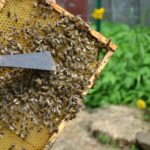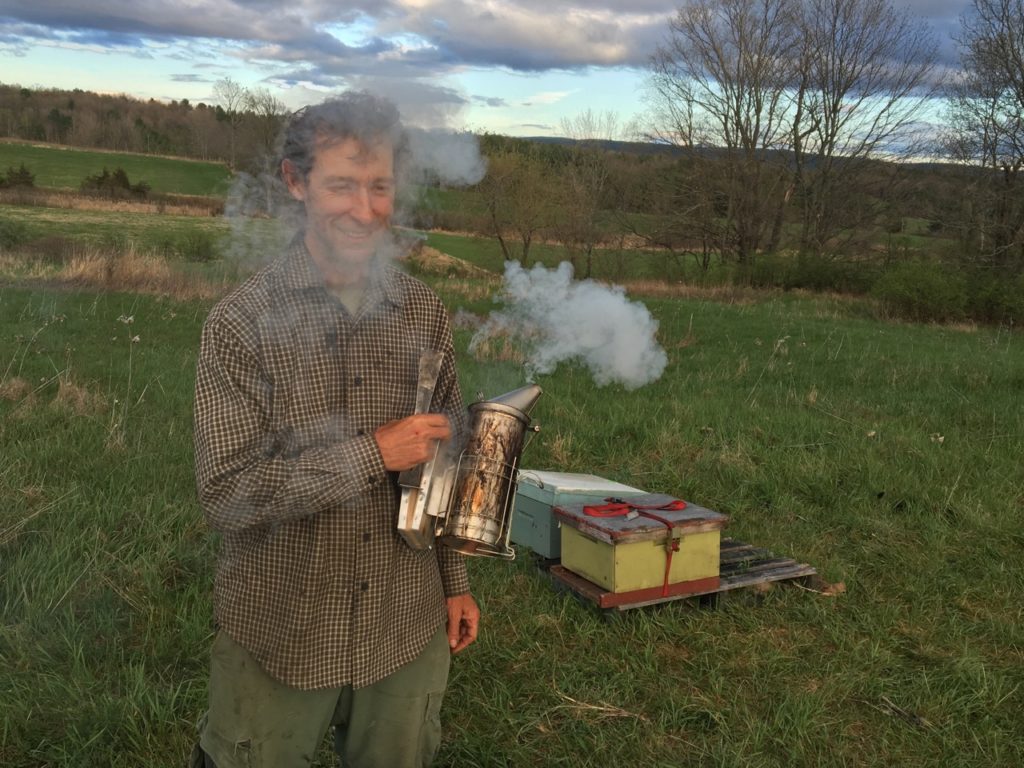Honey bees on the farm will pollinate our flowers. Todd began a relationship with honey bees over 50 years when he and his brother Tom, 9 years old, bought their first hive for their family farm. They were enchanted by how industrious the bees were, giving them honey, pollen, propolis and beeswax for candles and salve. Around 40% of what is eaten is pollinated by insects, this to a great degree by honey bees. Because there are so few nectar & pollen plants on Thornhill Farm, we are planting these plants for the bees. We know the soil is worn out on the farm because our honey bees make so little honey. This is why we have pigs. When the forest is cleared, we do not burn the wood that is left behind, but chip it and mix these wood chips with manure and fungus mycelium to make piles of compost to improve the soil. Last summer we grew peas and oats as a green manure crop, and the pea flowers gave voluminous amounts of nectar to the honey bees and pollinating insects.
Health & the Hive: A Beekeeper’s Journey
 A Jan Cannon Film that explores the importance of honeybees in our lives through the seasons of Honey Gardens Apiaries, Todd and the team. Topics addressed in the film include pollination, queen breeding, disease control, bee venom therapy, organic agriculture and honey-based plant medicine. 53 minute dvd. $10 + $4 (shipping).
A Jan Cannon Film that explores the importance of honeybees in our lives through the seasons of Honey Gardens Apiaries, Todd and the team. Topics addressed in the film include pollination, queen breeding, disease control, bee venom therapy, organic agriculture and honey-based plant medicine. 53 minute dvd. $10 + $4 (shipping).
to order, send a check to: 198 Taylor Road, Greensboro Bend, Vermont 05842
writings & images about the honey bees of Thornhill Farm
- Tim McFarline, McFarline Apiaries, Benson, Vermont June 3, 2016

Tim McFarline, McFarline Apiaries, Benson, Vermont. Tim raises queen bees organically from survivors and sells colonies of bees each Spring. We worked together for six years. May 2016.
Live from the Hive by Annie Watson – Winter 1997 to July 2015 archives
- Live from the hive: February 2015“Bees in the cold” by Annie Watson, Thistle Hill Studio We are concerned about the bees in this long bout of cold weather. At my house in central Vermont, the thermometer hasn’t gone above 32 degrees since some time in December. Did you know that honey bees do not eliminate their wastes inside the hive? To ...
- Live from the hive: January 2015“Winter Miracles” by Annie Watson, Thistle Hill Studio It’s a miracle that honeybees can survive the long cold northern winter. They do this by clustering in a warmth-preserving ball around their one and only queen, upon whom the whole colony depends to provide the eggs for the next generation. They detach their wings from their flight ...
- Live from the Hive: December 2014“Winter Solstice,” by Annie Watson, Thistle Hill Studio The cold and snow have arrived in the north country. Beekeepers have wrapped and insulated their hives to help the bees stay warm through the next few months. This is such a sweet season. The holidays give us an opportunity to celebrate life, get outside and enjoy the snowfalls, ...
- Live From the Hive: November 2014“Honey, the Magical Food” by Annie Watson, Thistle Hill Studio Imagine a food which has an incomparable rich sweet flavor, never spoils, and contains proteins, vitamins, minerals, and antioxidants. That’s honey. Honey is truly a magical substance. For thousands of years it was the only sweetener known to man. It’s mentioned in many ancient texts, from the ...
- Live From the Hive: October 2014“Asters” by Annie Watson, Thistle Hill Studio On a recent sunny afternoon walk, I spotted fall-blooming aster flowers alive with pollinators such as wasps, solitary bees, butterflies, and honey bees, all loading up on pollen and nectar. Aster flowers come in many colors and sizes, from the rich violet-colored New England Aster to the not-so-showy Bushy Aster, ...